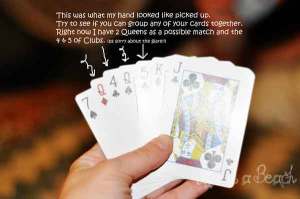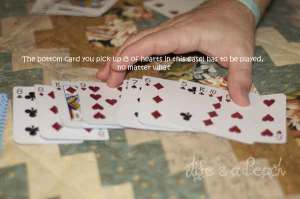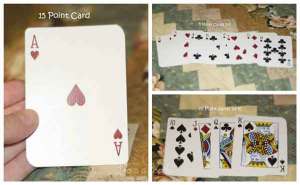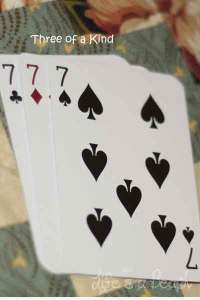How to Play Rummy
When my husband and I started dating, we got into playing Rummy. He didn’t know how to play at the time, however my grandma and I played when I was a little girl so I taught him. Now it’s one of our favorite past times. In fact, we’ve taught Tbug and she’s so addicted that’s pretty much all we hear over and over and over while she’s with us. Well that and Can we play John Deere Monopoly (which is the JD version of regular Monopoly).
So if you’re looking for a fun game to play, might I suggest this one. It might sound difficult but really it isn’t. Heck in college I always walked around carrying a deck of cards and taught a lot of people how to play between classes.
Deck- All 52 cards
Players- 2 to 5
Deal: 7 cards to each player. Flip over one card to start the discard pile. Place the stockpile and the discard plie card in the center of the table, where all players can get to them.
Object: To score 500 points. (or set points as you choose fit for your game.)
Course of play:
After the deal, all players receive time to organize their cards. The person on the dealer’s left goes first, continuing clockwise.
1.A player may start his turn by drawing a card from the pile or picking up discards, going as far back into the discard pile as he wants. If a player goes back to a certain card, he must immediately play that card in a meld. (see “The Melds” below). Laying off this card does not count as a meld for this purpose.
2. He may meld any of the other cards he picked up. You may meld any valid combinations in your hand as many times as you wish and/or are able to.
3. A player must always end his turn by discarding a card (his choice). Lay the discards down in a way so the rank and suit of each are visible.
Calling “Rummy”: If a player discards a card that may be laid off on other cards, the first player to notice it calls “Rummy” and plays the card for his benefit. A card counts a discard once a player takes his hand off it. This rule is nullified if no player notices it until the next player discards. Also, the next player still takes his normal turn if this happens, even if he is the one who picked up the discard. A player who picks up from the discard pile can indeed use the card in a meld or lay it off along with the meld he is forming from the discard pile.
If a player has no discard, play continues as usual. On his next turn, he draws a card. If it is playable, he must play it. If it is not playable, he discards it and the hand is over. The hand is always over when a players discards his last card. A player cannot discard his last card if it is playable on any melds already on the table. Other players are allowed to check the final discard. The hand is also over when the draw pile is exhausted and the next player does not wish to pick up from the discard pile. Score the hand as follows:
Each card has a certain scoring value.
To score a hand, after it is over, count up the value of all of the cards you have played to the table (your melds, layoff cards you’ve played on your melds and layoff cards you’ve played on other people’s melds) and subtract the point value of all of the cards you have left in your hand.
If you end up with a negative number after doing this, you receive a negative score- not 0 points. If a negative score in one hand would give you a negative score for the entire game, you would still have a negative score- not 0.
Remember, first player to 500 points wins. If two or more players reach 500 or over on the same round, the highest amount over 500 wins the game.
Note: You could play to a different amount of points if you wish.
The Melds
A meld is a combination of cards from your hand which you place face up on the table, where it stays until the end of a hand. There are two types of combination which can be melded:
A group consists of three or four cards of the same rank, such as three sevens.
A sequence consists of three or more consecutive cards of the same suit, such as the Nine, Ten and Jack of Clubs. An ace can count as low or high but not both at the same time. So A-2-3 and Q-K-A are both valid sequences, but K-A-2 is not. Remember that the cards in a sequence must be all of the same suit.
As well as melding complete combinations, players are allowed to meld cards which extend combinations which are already on the table. This is called laying off. All melds and all previous layoff cards must be kept visible so other players can see layoff opportunities. The fourth card of the same rank can be added to a group of three. (Lay down the fourth Jack if 3 jacks are on the table, for example) Or extra consecutive cards of the same suit can be added to a sequence at either end. For example, if 9-0-10 of Hearts is already on the table, any player on their turn can add the 7 of Hearts and/or the Jack of Hearts. You may lay off of cards that are layoff cards. A player may lay off on his own meld.
Example:
8-9-10 of Hearts is on the table. The Jack & Queen of Hearts has previously been laid off on the 10. You may lay off the King and Ace of Hearts.
Sometimes, when laying off a card, there is more than one meld it could be attached to. In this case the player laying off must choose which meld to extend. For example, if there is the sequence 7-8-9 of Diamonds and the group 10 of Clubs-10 of Hearts-10 of Spades on the board, and you have a 10 of Diamonds in your hand, you can choose whether to add your 10 to the sequence or the group, but once it is played, it cannot be moved. If something like this happens, you must state whether you are attaching the card to the sequence or the group.
You do not have to “lay off” cards you have in your hand if you don’t want to.
Strategy
1. When a player is in the no discard stage or has only a few cards left in his hand, it’s generally a good idea to discard Aces or ten-pointers. (10, Jack, Queen, King)
These are 15 or 10 points against you respectively, which could really hurt your score.
2. Try not to discard a card that would be the second or third card of a possible meld when combined with other cards in the discard pile.
For example, if there is a King in the discard pile it is not a good idea to discard a King. Your King would be the second card of a possible meld. It’s likely that another person has a third ace and will pick up the discard pile. You might discard it on purpose to tempt another player to dig deep into the discard pile. You might want to do this to trap him with a lot of points when you’re about to go out. If you discard the third card of a meld, the other player doesn’t need any more cards and can go ahead and just pick it up. The same works for sequences.
Also, it’s a better idea to “tempt” another player by discarding cards that are part of low point value melds.
3. Watch the cards on the table. Use this information. For example, if two Aces are already laid down, it is fairly safe to discard an Ace, even if there is an Ace in the discard pile already. You can’t make 3 of a kind that way at least.
4. It’s generally not a good idea to pick up a lot of cards from the discard pile if another player could go out shortly (has only a few cards in his hand)(or has no cards (no discard)) You could be stuck with those cards, meaning you would have to deduct a lot of points from your score.
However, it’s a gamble that could pay off big.
5. There are a couple of occasions where you might have a meld, but wouldn’t want to play it. The most common example is an Ace-2-3 sequence. You might not want to play this, so that you can save the Aces for a group of three or four Aces or a Q-K-A sequence.
However, if you get the appropriate 4, by all means play the 2-3-4 sequence. You could “lay off” the Ace later if you wanted to.
The only 2 cases where you should play an Ace to an Ace-2-3 sequence or “lay it off” on a 2-3-4 sequence are:
1. When one of your opponents is about to go out and you want the 15 points out of your hand.
2. When 2 or 3 of the Aces have already been played or the appropriate King is used in a group of Kings.
Never discard an Ace with the appropriate 2-3-4 sequence on the table. An opponent could still call “Rummy” and get the points for himself.
6. Watch what cards your opponents have picked up from the discard pile. Use this information when deciding what to discard. For example, you know your opponent has picked up 2 Jacks and played neither. You would not want to discard another jack, which he could pick up.
Note: A card is considered “discarded” when a player places it on the discard pile and takes his thumb off of it.
And on a side note… I’m not going to lie, these are some of the best cards we’ve purchased to play with. If you’re ever out in Las Vegas, all the souvenir stores have them, they are cards that have been played on the casino of your choice.
Linked up here:
Creative Thursday
Delightfully Inspiring Thursday










I LOVE Rummy! Though Josh always wins! It is still fun!
My grandma taught me how to play when I was probably Tbugs age and I've loved it ever since.
I've told you before – I just thing it's so cute you play together 🙂
Haha I have Rummy on my phone. Me and a friend of mine used to play double rummy. It was a game we made up with 2 decks of cards. It was pretty fun, you had to have at least 4 of a kind and then you could do double runs for extra points. I don't really remember all of the rules, but it was fun playing that with 2 people, then the other person isn't always holding the cards you want.
Hi!
I'm your newest follower from Mingle With Us! I'm excited to get to know you!
Christie
http://satisfactionthroughchrist.blogspot.com
One of my favorite card games 🙂
I have been playing Rummy since I was a kid, used to play with my grandma every day after school!
I love Rummy! Will and I love to play cards too! It's such a fun thing to pass the time and not just watch tv or sit around.
I love to play rummy! I grew up playing it with my great grandmother who never “let” any of us win. Her strategy was to hoard all of her runs and tricks until she could lay them all down in one hand, use up all of her cards, and go out with guns blazing. It made my great grandfather SO MAD every time!
OMG Rummy-500!! My Nana taught me how to play this too. I remember being a kid when the adults would play this for HOURS after dinner. I never knew the real names of the elements though (meld, etc). It was just “the pile”. My Dad would always win, because he'd pick up the whole discard line. And we had a rule where you had to announce “Last Card” before you went out or else you lost the whole thing.
PS – I wish they had this in casinos — I KICK ASS at this game. LOL
Nicole,
Awesome tutorial. We LOVE rummy. I kick my hubby's butt all the time, hehehe. But we play to 500 or even 1000 so he can TRY and beat me 🙂 Thanks so much for linking up to Creative Thursday. Can’t wait to see what you share this week. Have a great week.
Michelle